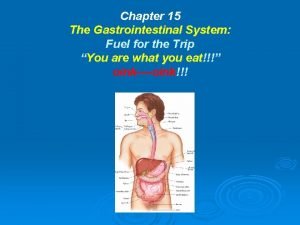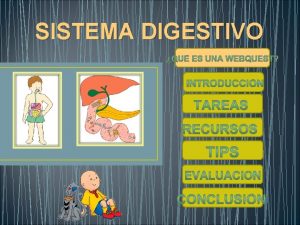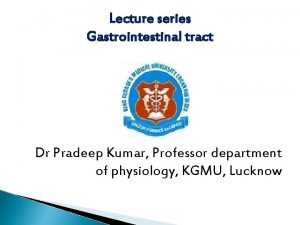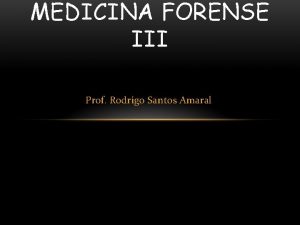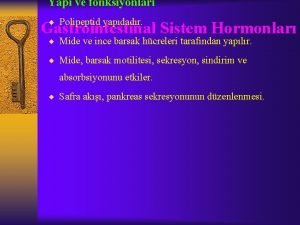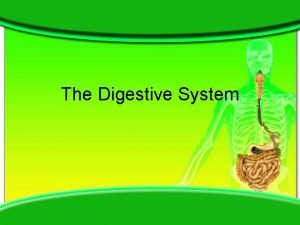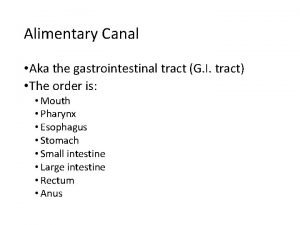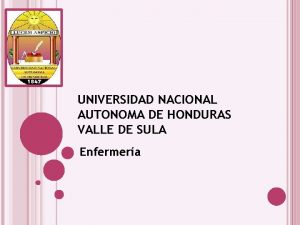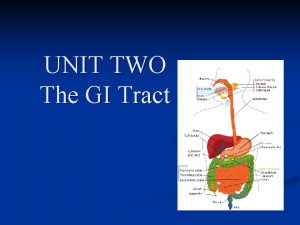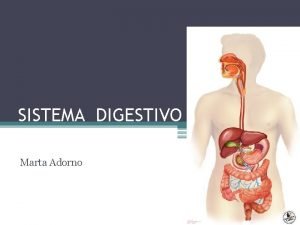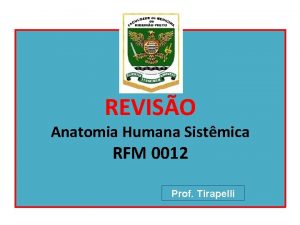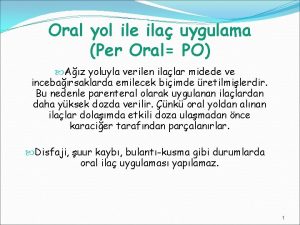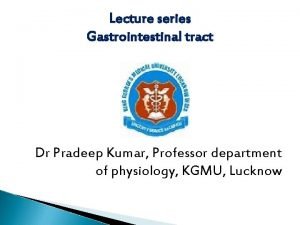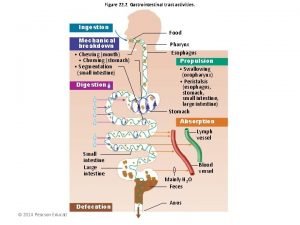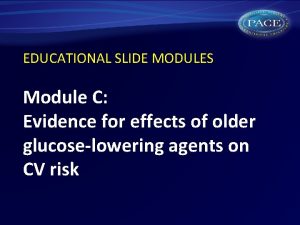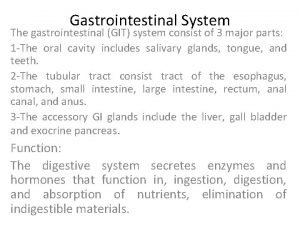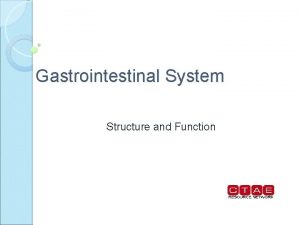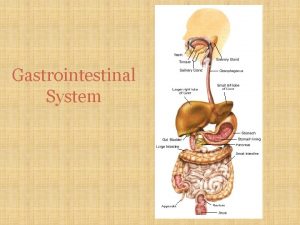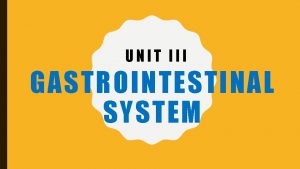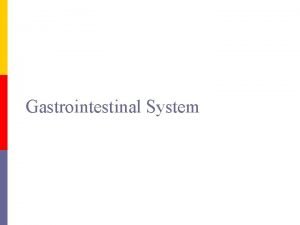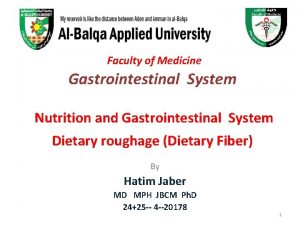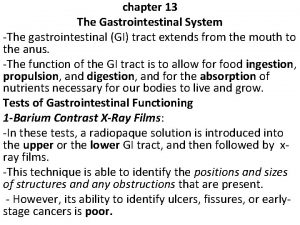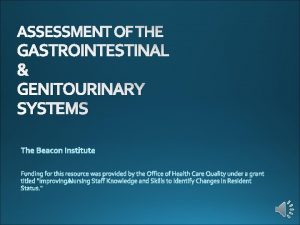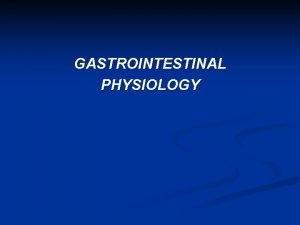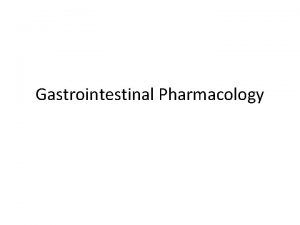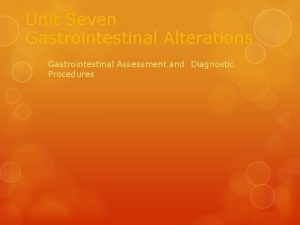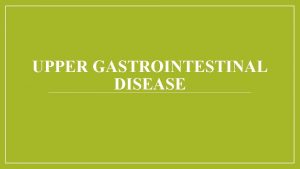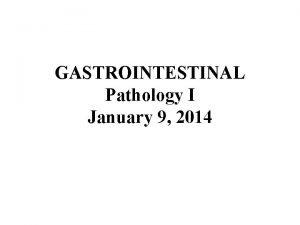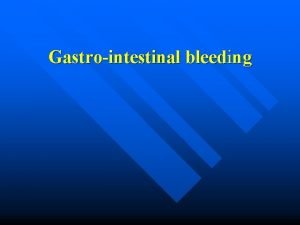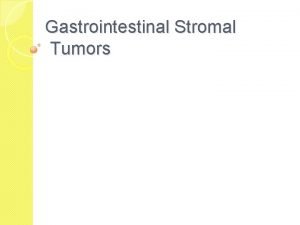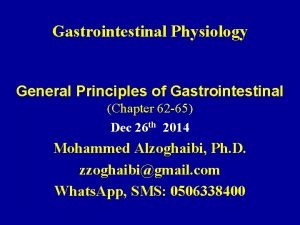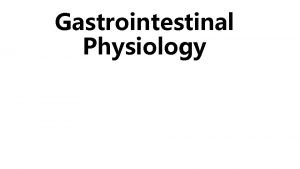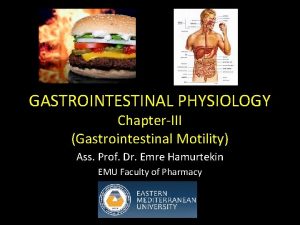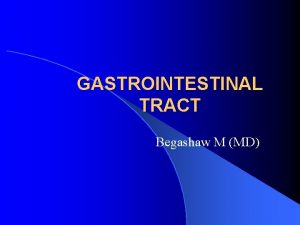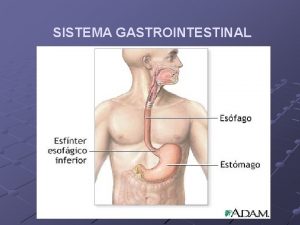Gastrointestinal System Understanding the gastrointestinal system It is





































- Slides: 37


Gastrointestinal System

Understanding the gastrointestinal system It is the body’s food processing complex It fuels the other systems with essential nutrients The GI system has two major components: q alimentary canal) and q the accessory glands and organs.


1. Mouth and esophagus The digestive process begins in the mouth. An enzyme in saliva, called ptyalin, begins to convert starches to sugars even before food is swallowed. Riding the peristaltic wave

Stomach Digestion occurs in two phases: cephalic phase and gastric phase. Phase 1: Break it down By the time food is traveling through the esophagus on its way to the stomach, the stomach secretes HCL and pepsin, to help break down food. Phase 2: Set the stomach on start The food exits the esophagus and enters the stomach, causing the stomach wall to distend. This stimulates the mucosal lining of the stomach to release the hormone gastrin

Gastrin serves two purposes: • stimulation of gastric juice secretion • stimulation of the stomach’s motor functions. The gastric juices mix with the food forming gruellike material called chyme. Hold it, mix it, and empty it out The stomach has three major motor functions: • holding food • mixing food by peristaltic contractions with gastric juices • slowly emptying chyme into the small intestine for further digestion and absorption.

Small intestine Nearly all digestion takes place in the small intestine Chyme passes through the small intestine propelled by peristaltic contractions. The small intestine has three major sections: the duodenum, the jejunum, the ileum. Dedicated to the duodenum Food passes from the stomach to the duodenum through a narrow opening called the pylorus. The duodenum also has an opening through which bile and pancreatic enzymes enter the intestine to neutralize the acidic chyme and aid digestion. This opening is called the sphincter of Oddi.

Just a jejunum? It’s the longest part! Digestive secretions convert carbohydrates, proteins, and fats into sugars, amino acids, fatty acids, and glycerin. Water, electrolytes, & nutrients are absorbed through the intestinal mucosa into the bloodstream for use by the body. Non-nutrients such as vegetable fibers are carried through the intestine.

Large intestine After chyme passes through the small intestine, it enters the ascending colon at the cecum, passes through the transverse colon, and then down through the descending colon to the rectum and anal canal, where it’s finally expelled. SUPER-ABSORBENT

Accessory glands and organs Liver The liver performs many complex and important functions, many of which are related to digestion and nutrition: • It filters and detoxifies blood, removing foreign substances, such as drugs, alcohol, and other toxins. • It removes ammonia from body fluids, converting it to urea for excretion in urine. • It produces plasma proteins, nonessential amino acids, and vitamin A. • It stores essential nutrients, such as iron and vitamins K, D, and B 12. • It produces bile to aid digestion. • It converts glucose to glycogen and stores it as fuel for the muscles. • It stores fats and converts excess sugars to fats for storage in other parts of the body.

Gallbladder The gall-bladder’s job is to store and concentrate bile, produced by the liver, which helps break down fats and neutralize gastric secretions in the chyme. Pancreas The pancreas is made up of two types of tissue: • exocrine tissue, from which enzymes are secreted through ducts to the digestive system • endocrine tissue, from which hormones are secreted into the blood. The pancreas’s exocrine function involves small, scattered glands—called acini—that secrete more than 1, 000 ml of digestive enzymes daily.


Gastro-esophageal reflux disease

Key points GERD, is a common condition characterized by prolonged reflux of hydrochloric acid, pepsin, and bile salts in esophagus, oral cavity, or respiratory system leading to esophagitis. Causes are related to the weakness or inappropriate prolonged / frequent transient relaxation of the LES, or delayed gastric emptying.

Key points The incidence of GERD increases markedly after age 40. It commonly occurs in pregnant or obese people. The chief symptom of GERD is frequent and prolonged retrosternal heartburn (dyspepsia) and regurgitation (acid reflux) in relationship to eating or activities. The reflux of gastric contents causes acute epigastric pain, usually after a meal. The pain may radiate to the chest or arms.

Key points Other symptoms can include: chronic cough, dysphagia, belching (eructation), flatulence (gas), atypical chest pain, and asthma exacerbations If untreated; GERD leads to inflammation, breakdown, and long-term complications. The primary treatment of GERD is diet and lifestyle changes, changes advancing into medication use (antacids, H 2 antagonists, and proton pump inhibitors).

Etilogy Any factor that relaxes the LES (smoking, caffeine, alcohol, or drugs). Any factor that increases the abdominal pressure (obesity, tight clothing at the waist, ascites, or pregnancy) Older age and/or a debilitating condition that weakens the LES tone. Contributing factors Diet: Excessive ingestion of foods that relax the LES include: Fatty and fried foods. Chocolate. Caffeinated beverages such as coffee. Peppermint. Spicy foods. Tomatoes. Citrus fruits. Alcohol.



Etiology Distended abdomen from overeating or delayed emptying Increased abdominal pressure (obesity, pregnancy, bending at the waist, ascites or tight clothing at the waist) Drugs that relax the LES, such as theophylline, nitrates, calcium channel blockers, anticholinergics, and diazepam (Valium) Drugs, such as NSAIDs, or events (stress) that increase gastric acid Debilitation or age-related conditions resulting in weakened LES tone Hiatal hernia (LES displacement into the thorax with delayed esophageal clearance) Lying flat





Diagnostic Procedures and Nursing Interventions v. History: Symptoms 4 to 5 times per week on a consistent basis v. Improvement after a 6 -week course of proton pump inhibitors (PPI) v. Diagnostic interventions taken to differentiate GERD from gastritis and from gastric/peptic ulcer (ulceration of gastric mucosa) Barium meal: pre & post. Nsg responsibilities Endoscopy is used while the client is under conscious sedation to observe for tissue damage (Nsg responsibilities). Esophageal manometry is used to measure muscle tone of LES and p. H monitoring.


Therapeutic Procedures and Nursing Interventions Surgery (fundoplication) may be indicated for clients who fail to respond. The surgeon wraps the fundus of the stomach around and behind the esophagus through laparoscopy to create a physical barrier. New option: Stretta procedure uses radiofrequency energy, applied by laparoscopy, to the LES muscle. This causes the tissue to contract and tighten.

Assessments Classic symptoms: Dyspepsia, especially after eating an offending food/ fluid, and regurgitation. Other symptoms: Symptoms from throat irritation (chronic cough, laryngitis), hypersalivation, eructation, flatulence, or atypical chest pain from esophageal spasm. Chronic GERD can lead to dysphagia (difficulty swallowing).

Assessments Assess the client’s: Dietary intake patterns, paying particular attention to foods containing caffeine and fat. Smoking history. Alcohol use. Weight.

NANDA Nursing Diagnoses Acute pain Deficient knowledge

Nursing Interventions Educate the client regarding: Diet Avoid offending foods. Avoid large meals. Remain upright after eating. Lifestyle Avoid tight-fitting clothing around the middle. Lose weight, if applicable. Elevate the head of the bed 15. 2 to 20. 3 cm (6 to 8 in) with blocks. The use of pillows is not recommended, as this rounds the back, bringing the stomach contents up closer to the chest.


Nursing Interventions Medications Encourage consistent appropriate use of prescribed medications: Antacids, should be administered when the acid secretion is highest (1 to 3 hr after eating and at bedtime). Antacids should be separated from other medications by at least 1 hr. Histamine 2 receptor antagonists (ranitidine (Zantac), famotidine (Pepcid), and cimetidine (Tagamet), reduce the secretion of acid. The onset is longer than antacids, but the effect has a longer duration. Proton pump inhibitors (PPI), omeprazole (Prilosec) reduce gastric acid by inhibiting the cellular pump necessary to secrete it. Studies show that PPI are more effective than H 2 antagonists. Medications such as metoclopramide hydrochloride (Reglan), increase the motility of the esophagus and stomach. Prokinetic; promote gastric emptying

Nursing Interventions Pain Management N&V management Nutritional needs management Assess for bleeding

Complications and Nursing Implications Risks associated with aspiration include: Asthma exacerbations from inhaled aerosolized acid. Frequent upper respiratory, sinus, or ear infections. Aspiration pneumonia. Formation of esophageal strictures (scarring). Erosive esophagitis, ulceration, and hemorrhage. Barrett’s epithelium (premalignant) and esophageal adenocarcinoma.

Any questions? ? ? ? ?
 Chapter 15 the gastrointestinal system
Chapter 15 the gastrointestinal system Embriologia del sistema gastrointestinal
Embriologia del sistema gastrointestinal Gastrointestinal tract
Gastrointestinal tract Chemotrypsinogen
Chemotrypsinogen Emt chapter 18 gastrointestinal and urologic emergencies
Emt chapter 18 gastrointestinal and urologic emergencies Gastrointestinal hormones
Gastrointestinal hormones Dr sigid djuniawan
Dr sigid djuniawan Esganadura
Esganadura Gastrointestinal sistem hormonları
Gastrointestinal sistem hormonları Gastrointestinal medical terminology breakdown
Gastrointestinal medical terminology breakdown Nutrition focused physical assessment
Nutrition focused physical assessment Embryology
Embryology Composition of stomach
Composition of stomach Motilidad gastrointestinal
Motilidad gastrointestinal Gastrointestinal diagram
Gastrointestinal diagram A digestão começa na boca
A digestão começa na boca Anatomia rim
Anatomia rim Conistipation
Conistipation Po ilaç
Po ilaç Gastrointestinal structure
Gastrointestinal structure Gastrointestinal
Gastrointestinal Metformin and constipation
Metformin and constipation Structure of alimentary canal
Structure of alimentary canal Nursing care for gastrointestinal disorders
Nursing care for gastrointestinal disorders Borborygmi
Borborygmi Hình ảnh bộ gõ cơ thể búng tay
Hình ảnh bộ gõ cơ thể búng tay Ng-html
Ng-html Bổ thể
Bổ thể Tỉ lệ cơ thể trẻ em
Tỉ lệ cơ thể trẻ em Chó sói
Chó sói Tư thế worm breton
Tư thế worm breton Chúa yêu trần thế alleluia
Chúa yêu trần thế alleluia Môn thể thao bắt đầu bằng từ đua
Môn thể thao bắt đầu bằng từ đua Thế nào là hệ số cao nhất
Thế nào là hệ số cao nhất Các châu lục và đại dương trên thế giới
Các châu lục và đại dương trên thế giới Công thức tính độ biến thiên đông lượng
Công thức tính độ biến thiên đông lượng Trời xanh đây là của chúng ta thể thơ
Trời xanh đây là của chúng ta thể thơ Cách giải mật thư tọa độ
Cách giải mật thư tọa độ
